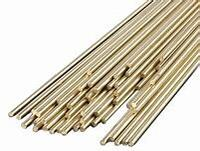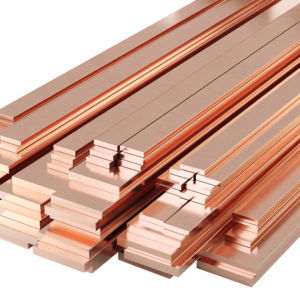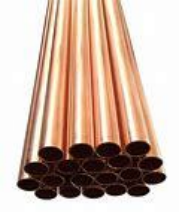1. Introduction
In the past 48 hours, global copper prices have surged due to supply chain disruptions in Chile—the world’s largest copper producer—triggering renewed interest in copper-based materials like copper rod. With industries from electrical engineering to HVAC scrambling to secure raw materials, understanding what copper rod is and how it’s used has never been more relevant.

Copper rod—also referred to as rod copper—is a versatile, high-conductivity metal product shaped into long cylindrical bars. Its exceptional electrical and thermal properties make it indispensable across multiple sectors. Whether you’re grounding an electrical system, welding copper components, or fabricating bus bars, there’s likely a copper rod variant designed for your needs.
2. Types and Applications of Copper Rod
2.1 Electrical Earthing and Grounding
One of the most critical uses of copper rod is in earthing systems. An earthing rod copper (or ground rod copper) safely channels electrical faults into the earth, protecting equipment and lives. Pure copper rods offer superior corrosion resistance but are costly, so many opt for alternatives like copper bonded earthing rod or copper clad steel ground rod.
These hybrid options—such as copper bonded steel or copper clad earth rod—combine a steel core for strength with a copper coating for conductivity. They’re widely used in telecom towers, substations, and residential grounding. When shopping, you’ll often see terms like copper clad steel earth rod or copper bonded ground rod; both refer to similar composite designs.
Pricing varies based on length, diameter, and copper thickness. If you’re comparing earthing rod price quotes, remember that higher copper content usually means better longevity—especially in corrosive soils.
2.2 Welding and Brazing
For metalworkers, copper rod for welding serves specialized roles. While pure copper isn’t typically welded like steel, copper welding rod and copper brazing rod are essential for joining copper-to-copper components without melting the base metal.
Copper to copper brazing rods and copper to copper welding rod types are formulated with phosphorus or silver alloys to ensure strong, leak-proof joints—common in plumbing and refrigeration. Similarly, welding rod copper variants help repair cast iron or join dissimilar metals where thermal expansion must be managed.
Always match the rod composition to your base material. Using the wrong copper rod welding consumable can lead to weak joints or oxidation issues.

3. Related Copper Products: Strips, Bars, and Pipes
3.1 Copper Strip and Flat Bar Variants
Beyond rods, flat forms like copper strip (sometimes misspelled as copper stip or copper stripes) are crucial in electronics and grounding. A copper strip for earthing—often sized 25x3mm—provides low-resistance paths in switchgear and panels. You’ll also find beryllium copper strip or nickel plated copper strip in high-performance connectors due to their spring properties and corrosion resistance.
DIY recyclers often search for the best way to strip copper wire or the fast way to strip copper cable when salvaging scrap. However, burning copper wire for scrap is dangerous and illegal in many areas—mechanical strippers or professional services are safer. If you’re sourcing materials, queries like ‘copper strip near me’ or ‘copper strip price’ can help locate suppliers of roll of copper strip or 1mm copper strip.
3.2 Copper Round Bar and Bus Bars
Copper round bar (or round bar copper) is essentially a thicker, machinable version of copper rod, used in bearings, valves, and electrical contacts. Flexible copper bus bar and copper flat bar serve in power distribution, while cu bars and copper bars for sale support everything from renewable energy inverters to industrial machinery.
3.3 Copper Tubing for HVAC and Plumbing
Air conditioning systems rely heavily on aircon copper pipe (also called ac copper pipe or air conditioner copper pipe). Sizes like 15mm copper pipe, 22mm copper tube, or 3/4 copper tubing are standard in refrigerant lines. Proper bending copper pipe and copper pipe soldering techniques prevent leaks and ensure efficiency.
While PEX plumbing pipes are gaining popularity for water lines, copper pipe and fittings remain the gold standard for durability. Prices fluctuate—check current ac copper pipe price or copper tube price before large installations.

4. Pricing and Market Considerations
Copper rod price hinges on LME (London Metal Exchange) rates, purity (ETP vs. oxygen-free), and form (solid vs. bonded). As of this week, rising demand in EV and solar sectors has pushed up costs for copper ingot and copper bar top grades alike.
When budgeting, compare not just upfront cost but lifecycle value. A copper bonded earthing rod may cost less initially than solid copper, but in salty or acidic soil, solid copper earth rod could last decades longer.
Similarly, copper strip wire and copper metal strips vary by alloy—beryllium copper strip commands a premium but offers unmatched fatigue resistance in springs and relays.
5. Conclusion
From earthing rods to welding consumables and HVAC tubing, copper rod and its derivative products underpin modern infrastructure. Whether you need a copper clad ground rod for a substation, a copper brazing rod for plumbing repairs, or thin copper strips for circuitry, understanding specifications and market trends ensures smart, safe choices. As copper remains central to the green energy transition, its role—and value—will only grow.
Our Website founded on October 17, 2012, is a high-tech enterprise committed to the research and development, production, processing, sales and technical services of ceramic relative materials such as What. Our products includes but not limited to Boron Carbide Ceramic Products, Boron Nitride Ceramic Products, Silicon Carbide Ceramic Products, Silicon Nitride Ceramic Products, Zirconium Dioxide Ceramic Products, etc. If you are interested, please feel free to contact us.

